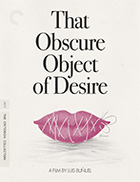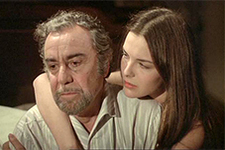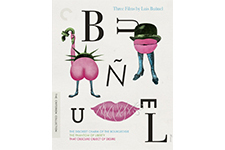| Director: Luis Buñuel | | Screenplay: Luis Buñuel in collaboration with Jean-Claude Carrière (based on the novel La Femme et le Pantin by Pierry Louÿs) | | Stars: Fernando Rey (Mathieu Faber), Carole Bouquet (Conchita Perez), Angela Molina (Conchita Perez), Maria Asquerino (Incarnación Perez), Julien Bertheau (Eduoard), André Weber (Martin, the valet), Milena Vukotic (Woman in train) | | MPAA Rating: R | | Year of Release: 1977 | | Country: France / Spain |  |
|  There are times when major dilemmas during the production of a film result in some inspired artistic decisions. For instance, Brian De Palma’s brilliant reimagining of the Odessa Steps sequence from Battleship Potemkin (1925) in The Untouchables (1987) was improvised on-set when De Palma was informed that the production did not have the resources to produce the scene as scripted by David Mamet. Another of the most famous “happy accidents” is the ending of Casablanca (1942), which rings with such perfection that it is nearly impossible to imagine the level of uncertainty that accompanied its filming. Such is the case with the brilliantly subversive decision by Luis Buñuel to cast two women for one role in his final film, The Obscure Object of Desire (Cet obscur objet du désir). Based on the famed 1898 erotic novel La Femme et le Pantin (The Woman and the Puppet) by Pierry Louÿs, Buñuel's film tells the story of a wealthy, middle-aged man named Mathieu Faber (Fernando Rey) and his increasingly frustrating pursuit of a young, unattainable woman named Conchita. When he originally began filming, Buñuel had cast Maria Schneider (Last Tango in Paris) as Conchita, but it quickly became apparent that they were not seeing eye-to-eye on the project. It is as at this point that Buñuel lighted on the idea of casting two different actresses to play the same role. Because Conchita is such an elusive and frustrating character, one who seems to be one person at a given moment and someone completely different the next, it made sense to have her portrayed by two different women who, while sharing certain similarities such as hair length and color, look nothing alike. Buñuel eventually cast Carole Bouquet, a cool French actress, and Angela Molina, a fiery Spanish dancer. There has been much ensuing discussion as to the logic of when Bouquet appears on-screen and when Molina appears. The most conventional explanation is that, when Conchita is passionate and sexual, Molina plays the role, and when she is evasive and difficult, Bouquet plays her. Thus, during a scene in which Mathieu thinks that Conchita is about to give up her virginity to him, we see Molina in the bathroom changing into a long lacy nightgown, but it is Bouquet who emerges into the bedroom and coldly refuses Mathieu’s advances. However, Buñuel has rejected this and other logical explanations, instead falling back on his surrealistic tendencies to let the very disruption it causes be the best reason. Using two women to play one role is a notable tear in the illusionary fabric of the classical Hollywood style, and yet it works marvelously; after the first few instances, we don’t blink an eye when one woman replaces the other. Despite the unconventional casting and portrayal of Conchita, The Obscure Object of Desire is otherwise one of Buñuel’s most conventional narrative films, telling a fairly uncomplicated story using a traditional flashback structure. There are no dream or fantasy sequences. Most of the characters are recognizable human beings who act in very human ways. We completely understand both Mathieu’s deep-rooted desire for Conchita and his increasing anger at the way she toys with that desire, constantly teasing and rejecting it. Thus, Conchita is the key to Buñuel’s understanding of the material—her unknowability is the story’s lynchpin. Conchita is not one character, but she is not two, either. Rather, she is a different character in every scene, making it impossible for Mathieu to understand her or please her. She is tricky, elusive, sometimes cruel, but always just out of reach. In the end, she is her own person, and the maddening complexity of her behavior is the opposite of how most movies oversimplify human desire to conventional romantic ends. It would be too easy, though, to see Conchita herself as “that obscure object of desire” implied by the title. Buñuel is up to something else, and the film’s title is crucial in this respect. After all, the title is completely his. Prior to Buñuel’s treatment, La Femme et le Pantin had been made into some half-dozen movies, most of which either retained the original title or devised something with even more misogynistic overtones, including Josef von Sternberg’s The Devil is a Woman (1935), which is an otherwise enjoyable comic riff on the novel that is notable as the director’s final collaboration with Marlene Dietrich. The centrality of sadistic female power over a man weakened by his chronically unfulfilled sexual longing implied in the title The Woman and the Puppet and The Devil is a Woman was jettisoned by Buñuel for something more abstract and infinitely more complex. As much as we would like to reduce Conchita to a sadistic tease, there is something more to her—a sense of principled willpower to remain her own person—that makes her compelling even when she is at her cruelest. In the end, she refuses to be an “object.” It is crucial, in this respect, that Buñuel chose the word obscure to describe the “object of desire,” thus implying that Mathieu is lusting after something he is not entirely sure of, something he cannot see with clarity. Mathieu is the narrator of the story, explaining his relationship with Conchita to a group of passengers on a train from Seville to Paris, but the title keys us into the fact that he is not to be trusted entirely. He tells the story, but it is his story from his point of view, which is not entirely reliable. Conchita—her sexuality, her spirit, whatever it is about her that Mathieu lusts after—is obscure, a word that carries connotations of being both ambiguous and potentially double-edged, inviting and dangerous at the same time. In the truest sense of surrealism, Matheiu’s sexual longings are for something irrational and elusive, not bounded by traditional cultural norms or simplistic understandings of what love is. In conventional terms, it is easy to see Mathieu’s actions as bordering on the masochistic, but, for Buñuel, this was true passion. Buñuel parallels this by including a running subplot involving repeated acts of terrorism that was not present in either the original novel or any of the other adaptations. Throughout the film, there are car bombings, hijackings, people shooting each other in the street—acts of extreme violence that are always threatening to crash in on Mathieu’s aristocratic comfort. Especially in today’s troubled times, this use of terrorism as a kind of parallel metaphor for sexual desire is both intriguing and terrifying. Surrealism, with its emphasis on the irrational and the nihilistic, taken to the nth degree is terrorism—violence for violence’s sake. It can always be dressed up in political explanations, but in the end it is the willful use of violence for the sole purpose of destruction and the fear and intimidation that comes with it. This is a heady subject for anyone to tackle, and even though he was 77 years old, Buñuel was more than up for the task. That Obscure Object of Desire is, like many of Buñuel’s works, a perversely funny film, especially in the way he undercuts conventional notions of both romance and cinema. Yet, the film’s disturbing undercurrents ensure that our laughter is tinged with a subtle sense of despair. Much like Mathieu’s fruitless pursuit of Conchita, the object of our desire in cinema-going is obscure and ultimately unknowable—do we want to laugh, do we want to cry, or do we want to do both at the same time? | That Obscure Object of Desire Blu-ray |  That Obscure Object of Desire is available as part of The Criterion Collection’s “Three Films by Luis Buñuel” box set, which also includes The Discreet Charm of the Bourgeoise (1972) and The Phantom of Liberty (1974). That Obscure Object of Desire is available as part of The Criterion Collection’s “Three Films by Luis Buñuel” box set, which also includes The Discreet Charm of the Bourgeoise (1972) and The Phantom of Liberty (1974). | | Aspect Ratio | 1.66:1 (all three films) | | Audio | French Linear PCM 1.0 monaural (all three films) | | Subtitles | English | | Supplements | The Castaway of Providence Street, a 1971 homage to Luis BuñuelSpeaking of Buñuel, a 2000 documentary on Buñuel’s life and workOnce Upon a Time: “The Discreet Charm of the Bourgeoisie”, a 2011 television program about the making of the filmInterviews from 2000 with screenwriter Jean-Claude CarrièreArchival interviews on all three films featuring Carrière; actors Stéphane Audran, Muni, Michel Piccoli, and Fernando Rey; and other key collaboratorsDocumentary from 1985 about producer Serge SilbermanAnalysis of The Phantom of Liberty from 2017 by film scholar Peter William EvansLady Doubles, a 2017 documentary featuring actors Carole Bouquet and Ángela MolinaPortrait of an Impatient Filmmaker, Luis Buñuel, a 2012 short documentaryExcerpts from Jacques de Baroncelli’s 1929 silent film La femme et le pantinAlternate English-dubbed soundtrack for That Obscure Object of DesireTrailersEssays by critic Adrian Martin and novelist and critic Gary Indiana, along with interviews with Buñuel by critics José de la Colina and Tomás Pérez Turrent | | Distributor | The Criterion Collection | | Release Date | January 5, 2021 | | | COMMENTS | | Criterion originally released all three of these films on DVD in the early 2000s, so it has been more than two decades since their original transfers. Each of the films in this three-disc set boasts a new, high-definition digital restoration, which has resulted in notably improved visual quality. All three films were transferred in high-definition from 35mm interpositives and their 35mm magnetic tracks. Compared to the DVDs, the images on these discs are brighter, sharper, and have better color and consistency, as well as demonstrably less signs of age and wear. All three films look great, with excellent detail and plenty of intact, visible grain. Some of the inconsistencies in the old DVDs, such as the notably increased graininess in the nighttime scenes in That Obscure Object of Desire, are less noticeable here. All three films feature their original monaural soundtracks in clean, Linear PCM transfers. That Obscure Object also includes an optional English-dubbed track. This set is, not surprisingly, absolutely bursting with supplementary material. Much of it has been ported over from the original Criterion DVD releases, but quite a bit of it is new, as well. On The Discreet Charm of the Bourgeoisie disc, we get a pair of outstanding documentaries from the original 2000 DVD: The first, El náufrago de la calle de Providencia (The Castaway on the Street of Providence), is a 24-minute documentary homage compiled by Arturo Ripstein and Rafael Castanedo, long-time friends of Buñuel’s with whom he used to drink martinis and have long talks while they were living in Mexico. The majority of the footage was filmed during these evening get-togethers in 1970, and the documentary is composed largely of Buñuel’s friends talking about him, as well as footage of Buñuel himself carefully making martinis, which to him was akin to a religious experience. The second documentary, A propósito de Buñuel (Speaking of Buñuel), is feature-length (it runs roughly 98 minutes). Directed by Jose Luis López-Linares and Javier Rioyo, it is an engaging examination of Buñuel’s entire career, from birth to death. It features on-camera interviews with several dozen people, including Buñuel’s two sons, many of his closest friends, and numerous actors and writers with whom he worked. The film will be interesting to both Buñuel novices and those who are familiar with his cinematic oeuvre, which spans 50 years and multiple countries. López-Linares and Rioyo follow Buñuel all over the world, from his initial collaborations with Spanish surrealists like Salvador Dalí, to his brief work at the Museum of Modern Art in Manhattan, to his extended career in Mexico (where he became a citizen), to his return to his native Spain. Although it does not cover in-depth every film Buñuel made (that would be quite a chore, considering that he directed 32 films), it does focus on Un Chien Andalou (1928), L’age d’or (1930), Las Hurdes (1932), Los olvidados (1950), Rehearsal for a Crime (1955), Virdiana (1961), The Exterminating Angel (1962), Simon of the Desert (1965), Tristana (1970), and That Obscure Object of Desire (1977). New to this edition is a 52-minute episode of the documentary series Once Upon a Time from 2011 that offers a deep dive into the film’s production and cultural history that includes interviews with screenwriter Jean-Claude Carriere, actors Stephane Audran and Bulle Ogier, and first assistant director Pierre Lary, among others. We also get “The Making of The Discreet Charm of the Bourgeoisie,” a 14-minute episode from 1972 of the French program Pour le cinéma that includes footage of Buñuel working on the set, as well as with interviews with him and actors Stephane Audran, Jean-Pierre Cassel, Bulle Ogier, Fernando Rey, and Delphine Seyrig. On The Phantom of Liberty disc, we get the same five-minute “introduction” to the film by co-screenwriter Jean-Claude Carrière, which is really an excerpt from a video interview recorded in 2000. He briefly discusses writing the script with Buñuel and what they were trying to accomplish (his favorite bit is the story about the parents looking for the lost child who is with them the whole time). Also included is “Analysis of The Phantom of Liberty,” a 20-minute visual essay from 2017 by film scholar Peter William Evans (author of The Films of Luis Buñuel: Subjectivity and Desire) that covers quite a bit of ground, with particular focus on Buñuel’s political, artistic, and cultural inspirations. We also get a 1974 episode of the French television series Pour le cinéma featuring Michel Piccoli and Jean-Claude Brialy; a 1974 episode of the French television series Le dernier des cinq that also features Brialy; and The Producers, a half-hour program from 1985 about producer Serge Silberman, who worked with Buñuel on five of his final seven films, including the three in this box set.. That Obscure Object of Desire’s disc is arguably the most loaded of the three. It ports over most of the supplements from the 2001 DVD, including an 18-minute video interview with Carrière, in which he discusses working with Buñuel, Buñuel’s directorial style, and the idea of using two actresses for the role of Conchita, among other things. We also get the inclusion of three scenes from Jacques de Baroncelli’s 1929 silent film version of La Femme et le pantin, the negatives for which were rediscovered in the 1990s. The three scenes—Conchita’s nude dance, her mocking Mathieu from behind the iron gate, and Mathieu’s violent attack on her the next day—correspond closely to scenes in Buñuel’s version (despite being a silent film, Baroncelli’s version is no less erotic or explicit in terms of nudity). Added to that, we get Lady Doubles, a 38-minute documentary from 2017 that includes interviews with Carole Bouquet and Ángela Molina, the two actresses who played Conchita; Portrait of an Impatient Filmmaker, Luis Buñuel, a 16-minute documentary from 2012 that includes interviews with cinematographer Edmond Richard and assistant director Pierre Lary, who recall their experiences collaborating with Buñuel on numerous projects; a 15-minute episode of the French television program Le monde du cinéma from 1977 featuring Carriére, Rey, and Silberman; “Remembering Buñuel”, a 30-minute episode of the French program Allons au cinéma from 1977 that documents a conversation among Carriére and actors Julien Bertheau, Muni, Michel Piccoli, and Fernando Rey about their experiences with Buñuel. All three discs includes original theatrical trailers, and the insert booklet features essays by critic Adrian Martin and novelist and critic Gary Indiana, along with interviews with Buñuel by critics José de la Colina and Tomás Pérez Turrent. All in all, this is a superb package that gives the films a fine presentation and is loaded with supplementary material. |
Copyright © 2021 James Kendrick Thoughts? E-mail James Kendrick All images copyright © The Criterion Collection |




 (4)
(4)

 That Obscure Object of Desire is available as part of The Criterion Collection’s “Three Films by Luis Buñuel” box set, which also includes The Discreet Charm of the Bourgeoise (1972) and The Phantom of Liberty (1974).
That Obscure Object of Desire is available as part of The Criterion Collection’s “Three Films by Luis Buñuel” box set, which also includes The Discreet Charm of the Bourgeoise (1972) and The Phantom of Liberty (1974). 